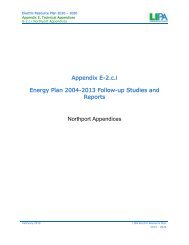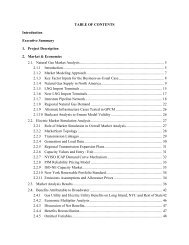Red Book - Long Island Power Authority
Red Book - Long Island Power Authority
Red Book - Long Island Power Authority
You also want an ePaper? Increase the reach of your titles
YUMPU automatically turns print PDFs into web optimized ePapers that Google loves.
** Important Safety Notice **<br />
The <strong>Long</strong> <strong>Island</strong> <strong>Power</strong> <strong>Authority</strong> (LIPA) actively promotes safety awareness around high voltage<br />
electric lines in its service territory. Whether you operate heavy equipment, or use ladders or scaffolding,<br />
you may work around electric power lines. Every year, some of our Trade Allies are injured or killed<br />
because they accidentally hit an overhead utility line.<br />
Awareness and Education is the First Step<br />
If you must work within 10’ of the overhead electric lines, contact LIPA to de-energize or relocate<br />
these lines so you can work safely. This 10’ distance is a requirement of Code Rule 57, also known as<br />
“High Voltage Proximity Act”. This New York State Labor Law requires safe work practices with respect to<br />
overhead wires, and proper clearances of wires to workers and structures. Further, it requires employers to<br />
contact the local utility a minimum of 5 working days prior to commencing work. LIPA frequently<br />
communicates on this subject with our Trade Allies through monthly electrical contractor and builder<br />
association meetings; scheduled meetings with municipalities, building department inspectors, engineers,<br />
architects; newsletters and various training seminars which LIPA offers throughout the year. LIPA<br />
welcomes any ideas and suggestions from these organizations on how to further expand this process. For<br />
further information, contact Customer Order Fulfillment.<br />
The Most Dangerous Situations to Watch For:<br />
Operating Large Equipment - Concrete pumping rigs, long-bed dump trucks, and other equipment can<br />
easily contact overhead power lines. Keep all equipment at least 10 feet away from power lines, poles, or<br />
towers. Work with a designated spotter whose only responsibility is to keep you clear of lines.<br />
Guiding Loads - If a crane or other equipment hits an overhead power line, electricity may travel through<br />
the tag line and through you. Don’t try to do double duty by guiding a load and spotting. Rely on a<br />
designated spotter.<br />
Ladder, Scaffolds, Tools and Supplies - Always be aware of your surroundings. Carry ladders, scaffolds,<br />
gutters and other long objects so they are even with the ground until you need to use them. If you carry<br />
them upright, you could hit an overhead line.<br />
Your Safety Steps:<br />
LIPA wants to make sure you and your co-workers avoid electric hazards:<br />
Locate overhead Lines – Survey your job site to find overhead power lines, poles, guy wires and service<br />
drops.<br />
Inform Co-Workers what’s Overhead and Underground – Make sure everyone at the job site knows<br />
about nearby overhead power lines and underground utilities.<br />
Remember the 10’ Rule – Keep all vehicles, equipment, tools and people at least 10 feet away from<br />
overhead power lines.<br />
Locate Underground Facilities – If you plan to dig, call the One-Call Center at 1-800-272-4480 or dial<br />
(811), 2-10 working days before digging so utilities can mark underground facilities.<br />
TO REPORT AN ELECTRICAL EMERGENCY CALL 1-800-490-0075






